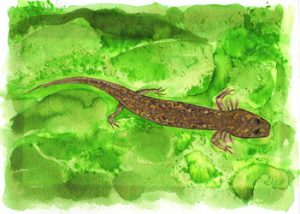 Hayley Gillespie ’03 worries about salamanders. Particularly Barton Springs salamanders. And she’s putting considerable educational power and research behind her concern. She successfully defended her Ph.D. on April 18, 2011, and graduated on May 21, 2011, from the University of Texas at Austin Graduate Program in Ecology, Evolution, and Behavior. She works for the City of Austin Salamander Conservation Program doing weekly population surveys of Barton Springs Salamanders at the four Barton Springs sites. She is preparing portions of her dissertation for journal articles, including one for Journal of Applied Ecology. See her new and previous published papers.
Hayley Gillespie ’03 worries about salamanders. Particularly Barton Springs salamanders. And she’s putting considerable educational power and research behind her concern. She successfully defended her Ph.D. on April 18, 2011, and graduated on May 21, 2011, from the University of Texas at Austin Graduate Program in Ecology, Evolution, and Behavior. She works for the City of Austin Salamander Conservation Program doing weekly population surveys of Barton Springs Salamanders at the four Barton Springs sites. She is preparing portions of her dissertation for journal articles, including one for Journal of Applied Ecology. See her new and previous published papers.
Hayley’s Austin College education included a major in biology and minors in art and environmental studies. She has made creative connections between these disciplines to more effectively visualize abstract biological concepts and clearly communicate her work to others. During her dissertation, she collaborated with artist Victoria Harrell from Conroe, Texas, to create illustrations about her work on the salamanders. In an effort to promote creative endeavors in science communication and interdisciplinary studies Hayley writes about the intersection of biology and the arts on her new science blog.
Hayley’s work, in her own words:
I have always been interested in how human activities across landscapes affect native wildlife. To conserve native species and their habitats effectively, we must have a good understanding of these effects. When I was a student at Austin College (Class of 2003), I studied how human activities affect zooplankton in Lake Texoma, native beetles in Hawaiian rainforests, and native plant communities at Sneed Environmental Research Area. I continued this interest in graduate school at the University of Texas at Austin where I studied the behavioral ecology of the endangered Barton Springs Salamander (Eurycea sosorum). Behavioral ecology examines the ecological and evolutionary basis for animal behavior and how that behavior influences the ability of the salamanders to survive and adapt to their environment.
The Barton Springs Salamander is known from only four small springs near downtown Austin, Texas (a total geographic range about the size of the Austin College campus!). This species is threatened by increasing human development over the surface of the aquifer that feeds Barton Springs. In order to protect and conserve populations of the Barton Springs Salamander, we must know how these endangered amphibians interact with both predators and prey. Until now, not much was known about these interactions. The goals of my dissertation research on the Barton Springs Salamander were to identify which senses the salamanders use to detect predators, which invertebrate species are the preferred prey of the salamanders, and which environmental variables are most important to growth of salamander populations.
 Overall, I made some very interesting discoveries about the Barton Springs Salamander that will help manage and conserve this endangered species. First, I found that the salamanders primarily use vision and electroreception (the ability to detect tiny electrical signals in water) to detect predators, not smell as do many other species of salamander. Second, by using a technique called stable isotope analysis, I discovered an entirely new prey item (the flatworm!) that had been overlooked completely in the two decades since the Barton Springs Salamander was listed as endangered. This finding will help biologists monitor prey in the springs and will help guide the diet of salamanders in the captive breeding program. Finally, I found that reproduction in the salamanders tends to occur only after years with much cold winter rainfall. This bears watching in the coming years as our climate changes.
Overall, I made some very interesting discoveries about the Barton Springs Salamander that will help manage and conserve this endangered species. First, I found that the salamanders primarily use vision and electroreception (the ability to detect tiny electrical signals in water) to detect predators, not smell as do many other species of salamander. Second, by using a technique called stable isotope analysis, I discovered an entirely new prey item (the flatworm!) that had been overlooked completely in the two decades since the Barton Springs Salamander was listed as endangered. This finding will help biologists monitor prey in the springs and will help guide the diet of salamanders in the captive breeding program. Finally, I found that reproduction in the salamanders tends to occur only after years with much cold winter rainfall. This bears watching in the coming years as our climate changes.
Sometimes conservation research—especially on endangered species—can be challenging. There are many special permits and much red tape to deal with; there’s not much preliminary biological information to go on; and sometimes observing very small population sizes can be discouraging (especially in this drought). But, you just have to keep working for change! One of my favorite quotes from Dr. Seuss’ The Lorax often inspires me to continue in conservation research when I worry about the salamanders’ future, “Unless … unless someone like you cares a whole awful lot, nothing’s going to get better. It’s not.”

